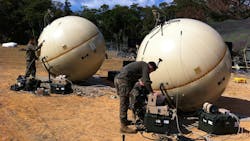Marine Corps chooses troposcatter communications system from Cubic GATR to replace service's AN/TRC-170
QUANTICO MARINE BASE, Va. – U.S. Marine Corps communications experts needed a next-generation troposcatter radio to replace the service's AN/TRC-170 tropospheric scatter microwave radio terminal. They found their solution from Cubic GATR Technologies Inc. in Huntsville, Ala.
Officials of the Marine Corps Systems Command at Quantico Marine Base, Va., announced a $325 million 10-year contract to Cubic GATR on Tuesday for as many as 172 Next Generation Troposcatter systems.
Troposcatter communications systems enable warfighters to establish a communications capability in areas where access to a trusted source of satellite communications coverage is not available.
The contract includes manufacturing and delivery, test support, technical data delivery, logistics data delivery, training data delivery and training support, fielding support and sustainment support.
Related: Army revisits troposcatter communications technology as alternative to long-range SATCOM
The Marines has asked Cubic GATR for a troposcatter system as potential replacement for the AN/TRC-170. The Next Generation Troposcatter system will be based on commercial and non-developmental item technologies able to meet Marine Corps requirements.
Tropospheric scatter, or troposcatter, enables communications with microwave radio signals over distances of nearly 200 miles by randomly scattering UHF and SHF radio waves as they pass through the upper atmospheric layers of the troposphere.
Troposcatter transmits radio signals in a narrow beam aimed just above the horizon in the direction of the receiver station. As the signals pass through the troposphere, some of the energy scatters back toward the receiver station.
GATR Technologies pioneered an inflatable satellite communications (SATCOM) antenna design that is portable, easy, and quick to set up. The company is capitalizing on its ultra-portable SATCOM antenna technology to troposcatter communications. Cubic Corp. in San Diego acquired GATR Technologies in 2015.
In 2016 GATR introduced the C-band GATR Tropo four-meter troposcatter antenna, which can be packed into five cases that collectively weigh less than 620 pounds. The new inflatable GATR Tropo antenna, which is available in 2.4 and four meters, are able to receive troposcatter signals over diverse terrains when the antennas are elevated to 12 feet.
The Cubic GATR Next Generation Troposcatter system is to replace the Marine Corps AN/TRC-170, which consists of air- or ground-transportable troposcatter microwave radio terminals that provide secure digital trunking between major nodes of the U.S. military TRI TAC communications network, or in stand-alone military communications applications.
TRC-170 links might carry dedicated traffic to include analog and digital channels, point-to-point subscriber circuits, facsimile circuits, and teletype circuits.
The AN/TRC-170 system includes antennas, radio transmitting and receiving equipment, digital multiplexing equipment, voice and data orderwire facilities, and built-in test equipment (BITE). The secure system has encryption of mission and orderwire traffic. The AN/TRC-170 involves a 9.5-foot dish-like antenna, and can require 2.5-ton trucks to transport.
Marine Corps leaders have asked Cubic GATR to package the Next Generation Troposcatter system in a four- or two-man-lift transit case with improved size, weight, and power (SWaP) attributes such that it is transportable on a light combat vehicle like a Joint Light Tactical Vehicle (JLTV), CH-53 helicopter, MV-22 tiltrotor aircraft, or C-130 fixed-wing utility aircraft.
The new troposcatter system will have security and encryption that meets National Security Agency (NSA) communications security modernization requirements, and can provide C- and X-band communications.
The Marine Corps has asked Cubic GATR to provide a troposcatter communications able to send and receive data at 50 megabits per second at distances of 35 to 50 miles, and 20 megabits per second at 120 to 160 miles; accept sufficient power from a 10-kilowatt generator; and that meets MIL-STD 810G, MIL-STD 461G, and MIL-STD 464C for ruggedization, resistance to electromagnetic interference, and ability to operate through exposure to harsh chemicals like fuel.
On this contract Cubic GATR will do the work in Huntsville, Ala., and should be finished by October 2029. For more information contact Cubic GATR online at www.cubic.com, or Marine Corps Systems Command at www.marcorsyscom.marines.mil.
About the Author
John Keller
Editor-in-Chief
John Keller is the Editor-in-Chief, Military & Aerospace Electronics Magazine--provides extensive coverage and analysis of enabling electronics and optoelectronic technologies in military, space and commercial aviation applications. John has been a member of the Military & Aerospace Electronics staff since 1989 and chief editor since 1995.
